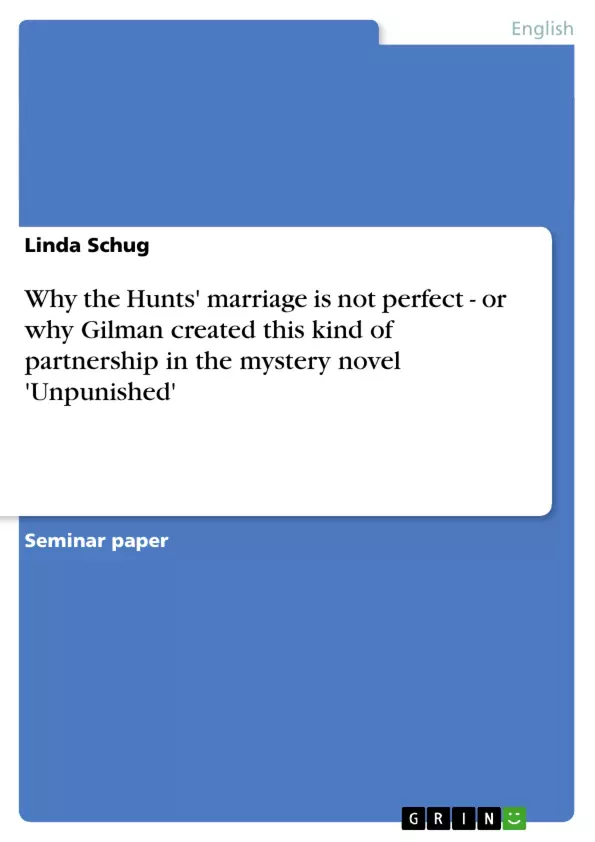I. Introduction
In the conclusion to Feminist Fiction, Anne Cranny-Francis (compare to 201-202) brings up the question: How can a feminist use the genre of detective fiction which seems superficially to be about detection and revelation, but which is ideologically about concealment and mystification? Charlotte Perkins Gilman made one of the earliest attempts in 1929 out of "feminist despair at what had become of her society and the movements to build a new one from it" (Robinson 276). "She wrote a novel, a spirited novel in a popular genre, the murder mystery, that would encapsulate her vision of feminism for the new times. The idea, this time, was not so much to hurl feminism into the jaws of post-feminism as to pry open those jaws and slip in a sugar-coated pill" (Robinson 277).
On the one hand, Unpunished has a feminist message about domestic abuse and marital rape. On the other hand, it contains a husband-wife detective team, common stock characters since 1913 (compare to G & K 101/103), not a single woman detective or at least a professional partnership as one could have expected. Creating this unequal couple, it could be said that Gilman adopted the conventions of detective fiction. First of all, I am going to summarize the history of detective fiction and fictional detectives created by women writers to demonstrate the prevailing conventions of the genre and the way these are converted in the book. I shall confine myself to a consideration of the detective couple Bessie and Jim Hunt disregarding their rival sleuth Gus Crasher. According to William Aydelotte, conventions are the elements that make detective stories popular because they correspond to wish-fulfillment fantasies and therefore describe the readers and their unmotivational drives (compare to 307-308). This theory appears interesting to me with regard to the fact that Gilman′s mystery was not published until 1997. Its underlying fantasies seem to have produced certain sensations that the publishers and the readership were not ready for yet. My thesis is that Gilman used the detective couple to make fun of the conventions of the genre and to show that little has changed for women. In the next section, taking the usage of (nick)names and the partnership presented in the book as examples, I will try to prove this against the background of the society and the gender relations in the nineteenth century and in the 1920s.
Inhaltsverzeichnis (Table of Contents)
- I. Introduction
- II. Main Part
- 1. The Genre: Detective Fiction
- 1.1. Historical Background and the Creation of Conventions
- 1.2. Fictional Detectives by Women Writers - Conventions of the 1920s
- 1.2.1. Male
- 1.2.2. Female
- 1.2.3. Couples
- 1.3. Unpunished - The Mystery Novel
- 1.3.1. The Detective Couple
- 1.3.2. Jim Hunt
- 1.3.3. Bessie Hunt
- 2. The Role of Women in Society
- 2.1. In the Nineteenth Century
- 2.2. In the 1920s
- 2.3. Gilman's Ideal
- 3. The Hunts' Marriage
- 3.1. Jim Hunt
- 3.2. Bessie Hunt
- 3.3. Telling Names
- 3.3.1. His
- 1. The Genre: Detective Fiction
- III. Conclusion
Zielsetzung und Themenschwerpunkte (Objectives and Key Themes)
The main objective of this analysis is to explore the unusual marriage dynamic presented in Charlotte Perkins Gilman's Unpunished, focusing on the way Gilman utilizes the conventions of detective fiction to satirize societal expectations of women. The text aims to demonstrate how little had changed for women in the early 20th century, despite the emerging feminist movements.
- The evolution of the detective fiction genre, particularly the portrayal of women as detectives.
- The role of women in society during the 19th and early 20th centuries.
- The portrayal of the Hunts' marriage and its implications for Gilman's feminist views.
- The use of names and conventions within the detective fiction genre to further Gilman's critique of societal norms.
Zusammenfassung der Kapitel (Chapter Summaries)
The introduction delves into the complex relationship between feminist ideals and the genre of detective fiction. It highlights Gilman's novel, Unpunished, as an early attempt to reconcile these seemingly conflicting themes. The analysis then focuses on the historical background of detective fiction, tracing its evolution from early puzzle stories to the conventions of the 1920s. This includes examining the portrayal of fictional detectives, particularly the prevalence of male characters in the works of female writers. The chapter concludes with a discussion of the conventions of the genre and their potential for satirizing societal expectations, particularly concerning women.
The main part of the analysis begins with a detailed examination of the detective couple in Gilman's Unpunished, analyzing their individual characteristics and roles within the narrative. The analysis further examines the portrayal of women in society, exploring the prevailing attitudes toward women in both the 19th and early 20th centuries. This chapter concludes by discussing Gilman's own ideal for women's roles and her critique of the societal norms that hinder women's progress.
The final section delves into the complexities of the Hunts' marriage, analyzing the power dynamics and gender roles that underpin their relationship. The analysis then examines the symbolic significance of the characters' names and the way these choices reinforce the themes of societal expectations and gender inequality. The chapter concludes with a discussion of the impact of Gilman's unique approach to the detective genre, highlighting her ability to subvert conventions and offer a critical commentary on women's struggles in the early 20th century.
Schlüsselwörter (Keywords)
The main keywords and themes of this analysis include: detective fiction, feminist fiction, conventions, societal expectations, women's roles, marriage, gender inequality, Charlotte Perkins Gilman, Unpunished, Jim Hunt, Bessie Hunt, domestic abuse, marital rape, detective couples, and the 1920s.
- Quote paper
- Linda Schug (Author), 2002, Why the Hunts' marriage is not perfect - or why Gilman created this kind of partnership in the mystery novel 'Unpunished', Munich, GRIN Verlag, https://www.hausarbeiten.de/document/47515


